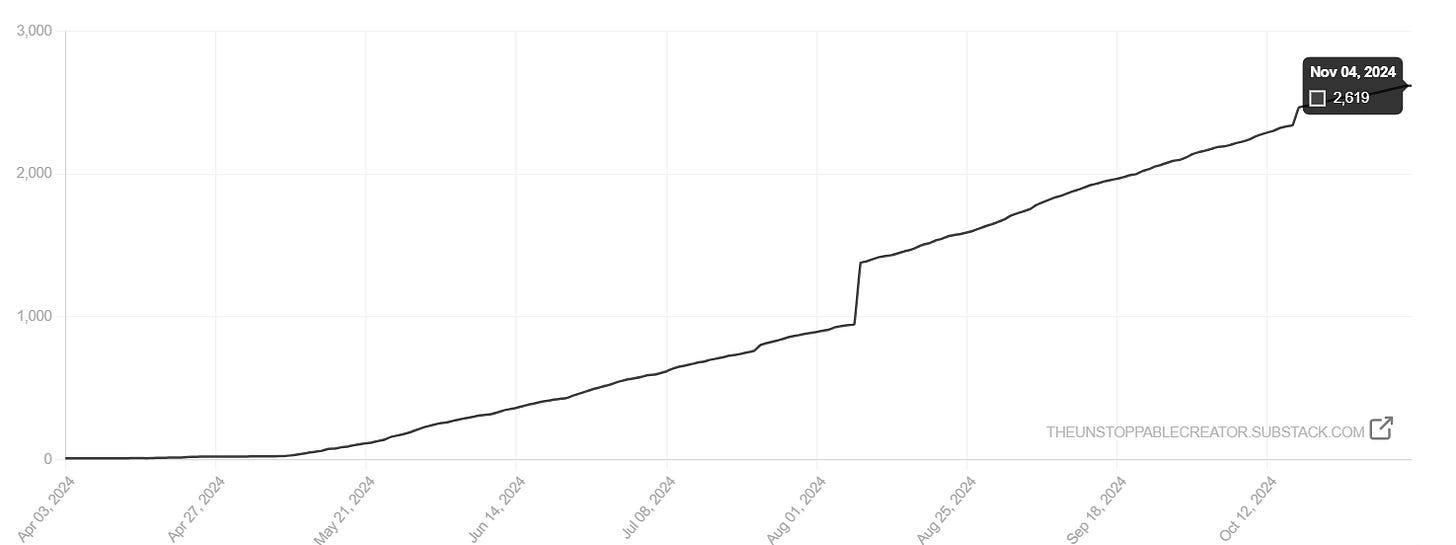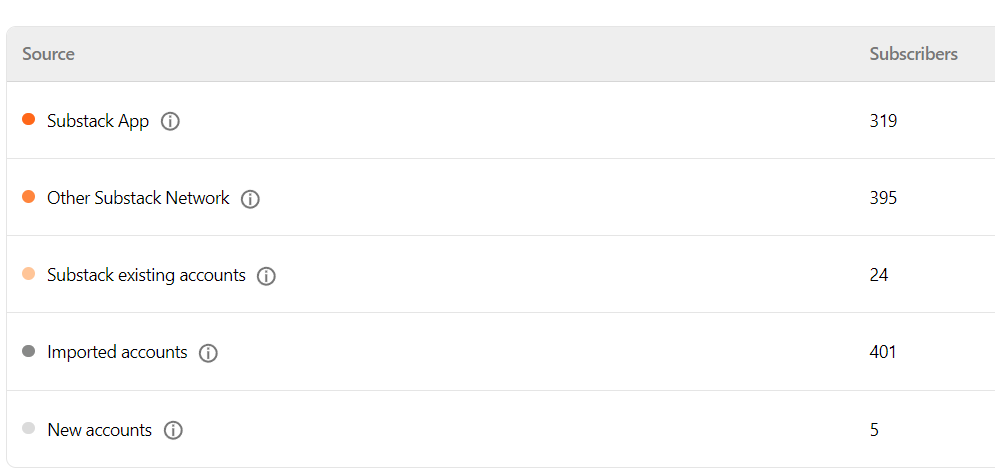How I Gained 700+ Subscribers on Substack in 6 Months (Without External Traffic)
Here's why and how you should build your audience on Substack, even if it's not all unicorns and rainbows.
🤩 Hey! I’m Alberto. With my newsletter I want to help you reach your full potential and live your ideal life with a content-based business.
I talk about productivity, automation, strategy and mindset.
Yesterday was my first Substack half-birthday. I published my first article here on May, 4th, 2024. Yay!
It's been an intense and exciting journey so far. I’m grateful I took the plunge and started writing on this platform. But it hasn't all been smooth sailing.
Today, I won’t tell you how I became a bestseller. Or how Substack changed my life.
I want to give you, as always, a realistic view of what you can expect starting from zero, what worked, and what didn’t.
Things you must know
I hate when people share their achievements out of context. They aren’t teaching. They’re bragging. So, let’s try to do better.
I've been a full-time content creator for over 14 years. Though I spent most of those years creating content in Italian, I’m not a total beginner. I studied and practiced many tactics. I know how to write a decent article. I know how to use the tools.
I’m also a full-time solopreneur. I’m not doing this on the side. Since I’m running my business in Italy, I spent about half of my working time on Substack.
Finally, I write for creators. Many people join Substack to build their creator career, so I may have had an advantage. That said, the top-selling publications on Substack are in totally different niches. So, I might actually be at a disadvantage.
Now, let's cut to the chase.
My Substack numbers, after 6 months
Here’s a screenshot of my dashboard taken on November 4th, 2024, 6 months after my first article went live:
Side note: a few weeks ago, my 30 day views, the open rate, and the 30 days growth were far more exciting. I’m still figuring out what’s happening. I’ll talk about this later.
You need a couple more screenshots to have a complete understanding. I reached 2619 followers on Notes:
My content received about 25000 views in total:
Finally, I imported a little over 400 subscribers. This means I gained a little over 700 subscribers through Substack, since I didn’t use any other external source.
The single number that makes Substack worth it
I’ll show you later that Substack hasn’t been all unicorns and rainbows. An experience confirmed by many other authors I talked with.
But one thing currently makes it a surefire investment. In these 6 months, I earned almost 4 subscribers every day, on average.
I’m talking of email subscribers, not followers:
They’re a guaranteed source of views, independent of algorithms. On average, 30% of them are opening my emails.
As every online marketer knows, email is the highest converting channel. So, my subscribers are the best audience to sell my products to.
If Substack stops working, I can move my subscribers to any other email marketing tool and keep sending them my content and offers (I’m already doing it).
I've posted two articles every week and one or more notes daily, except on weekends. I’ve also spent 15 to 30 minutes engaging with other people's posts each workday.
If I had put the same effort into my own blog outside of Substack, while also posting on any other social network, I’m sure by now I would have far fewer email subscribers. I know because I tried.
Substack now provides a very high ROI to new creators. In other words, if you publish valuable content consistently, you get views and subscribers.
Now, what worked for me?
Recommendations are the easiest win
If you're new to this platform, here's how recommendations work:
you add a publication to your recommendation list,
when someone subscribes to your publication, Substack automatically shows them three recommendations from your list,
these recommendations also appear on your publication homepage,
occasionally, Substack sends automatic emails with one or more of your recommendations to your subscribers,
the people you recommend get new subscribers effortlessly as your audience grows,
the recommended authors will reciprocate and recommend you.
When I started, I figured if I manually curated the recommendations that best matched my publication, I'd bring the highest number of quality subscribers to the recommended authors. This way, they would have been happy to recommend me. So I started reaching out to creators I liked whose publications and audiences seemed aligned with mine.
But I found out this isn't necessary. It seems there is an algorithm deciding which publications to show from your list, but no one figured out how it works. And often, even when a publication seems a good match, it doesn’t bring or get many subscribers.
I talked with other creators, some with far more subscribers than me. They made the same observations. Everyone agrees the optimal strategy for now is to just recommend anyone, for two reasons.
First, the algorithm takes care of whom to recommend from your list. Second, you might inspire reciprocation. Every time you recommend an author, they might recommend you in return. You never know when a publication will start growing fast and bring you dozens of subscribers.
In my first 6 months, 65% of my subscribers came from recommendations. A handful of recommendations brought half of these subscribers. By the way, I’m not talking about the largest or the fastest growing publications.
I actively exchanged about a dozen recommendations. The rest came organically.
Notes is an unreliable rollercoaster
Notes is Substack's internal social network. It started as a channel to update your subscribers quickly. But when they introduced an algorithm, people started seeing hundreds of subscribers coming from a single successful note.
I've been using notes from the beginning, but with mixed results.
Those 319 subscribers with the source “Substack App” should come from Notes. But maybe also from guest posts. Substack analytics aren’t detailed enough.
So, I can’t say if I wasted hours every week writing on Notes. In the beginning, if I slowed down my engagement with other people’s notes, my subscriber growth slowed down accordingly. But now I can’t see the correlation anymore.
As I told you earlier, the last 2-3 weeks have been particularly disappointing. Despite doing the same things as before, my growth rate has worsened.
Other creators are equally puzzled by Notes. Some see their engagement explode, others lose momentum completely. And they can’t understand why.
I think the platform is too young. The algorithm was introduced just last year. The social networks we all know are over 10 years old. A lot still has to change in the near future.
That said, I never emulated the successful note templates that, over time, became trendy on the platform. This might play a role.
The most under-used growth tactic—perfect for Substack
Over 100 of my subscribers, possibly up to 200, came from five or six guest posts.
What's a guest post? It’s a form of collaboration, and a very effective growth tactic, as old as blogs. It simply involves publishing an article on another person’s publication.
Substack is perfect for this:
most authors are open to collaborations,
with a single click, they can add you as co-author to an article,
their audience then easily sees your bio, and with one click can read your publication,
you receive notifications when your guest post gets a comment, so you can promptly reply and build your credibility.
I saw how well guest posts work during my creator career. So, I soon started pitching guest posts to authors I knew, and they all accepted.
I not only got a lot of free subscribers from guest posts. I also got three or four paid subscribers.
And there are also two less measurable but still tangible outcomes. You create the impression of being everywhere and “absorb” credibility from the host author.
For more on growing through guest posts, check out this article.
The worst part
Monetization on Substack is much tougher than it seems. Paid subscriptions are easy to set up for you and to buy for your readers. But they remain the hardest sale. A one-off product or service has a much higher conversion rate.
I know my offer can be improved. And I never pushed it. But my conversion rate is tragic.
I studied and talked to established authors with much more paid subscribers than me, even bestsellers with more than a 100 paid subscribers. They confirm that:
the typical conversion rate is lower than 5%,
if you don’t keep selling in your articles and posts, people don’t buy,
you need hundreds of paying subscribers to make a living through Substack paid subscriptions. (Which means probably dozens of thousands of free subscribers)
I found a few exceptions. If you sell at very low prices, far less than $50 per year, or teach how to grow on Substack, or publish at a frantic pace (at least once per day), or catch some hot trend (like the US elections), the conversion rate might be higher.
So, what now?
The last few weeks have been strange. Notes is at peak unreliability, with basically zero ROI.
I hate being at the whims of capricious platforms. So, this could be my acquisition strategy for the next months:
keep posting on Notes, but investing the minimum amount of effort,
keep engaging on Notes with authors I find interesting,
look for new creators to engage with (the feed keeps always showing the same handful of names),
limit the time spent engaging to less than 30 minutes every day,
invest more time in collaborations, like guest posts and webinars,
exchange more recommendations (I’m a part of a mastermind that should make it easier).
But the real challenge is monetization. I will create small products, like ebooks and workshops, and sell them both as standalone products and as parts of my paid subscription. This way, I’ll speed up the feedback loop and maybe kill two birds with one stone.
My 6-month verdict
Substack is a platform you don’t want to sleep on right now. I’m seeing the same rate of organic growth that took my first blog to 300k monthly views, 14 years ago.
This is at least in part due to the platform’s young age. I usually don’t recommend exploiting trends or jumping from platform to platform. But Substack also allows you to create your own email list. No platform ever provided this feature.
So, if organic growth dies out in a year or two, you’ll still have hundreds of subscribers that you can send your content and your offers to.
If you’re struggling with your growth on Substack, or just starting out, here’s the basic strategy I recommend for the highest ROI:
find a broad but defined niche (this article can help),
publish a long-form article 1-2 times per week,
exchange recommendations
engage with interesting authors on Notes daily,
offer guest posts to authors with similar audiences, possibly larger than yours,
if you have time, test your ideas with short posts on Notes.
And if you need more help, become a paid subscriber by clicking here. You’ll unlock access to ask your questions in this publication’s chat.
You’ll also get:
Templates for automating your business and boosting productivity
My book: "Stress-free Niche Finding"
Dozens of tutorials and guides to help you become an Unstoppable Creator
Thanks for reading!








Ooooh! These practical, no-nonsense, actionable tips are EXACTLY what I need right now. Thank you! I am subscribing, recommending, and restacking you. Thank you, Alberto!
I haven't read anything but you're energy is marvelous, Darling!!